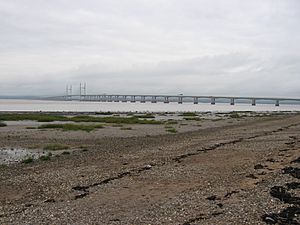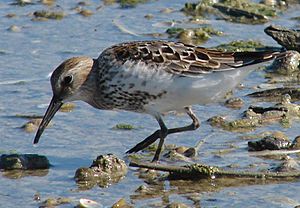Severn Beach facts for kids
Quick facts for kids Severn Beach |
|
|---|---|
 Severn Beach foreshore and Second Severn Crossing |
|
| OS grid reference | ST542848 |
| Civil parish |
|
| Unitary authority | |
| Ceremonial county | |
| Region | |
| Country | England |
| Sovereign state | United Kingdom |
| Post town | BRISTOL |
| Postcode district | BS35 |
| Dialling code | 01454 |
| Police | Avon and Somerset |
| Fire | Avon |
| Ambulance | Great Western |
| EU Parliament | South West England |
| UK Parliament |
|
Severn Beach is a small village in South Gloucestershire, England. It sits right on the edge of the Severn Estuary, which is where the River Severn meets the sea. The village is also very close to the eastern entrance of the Severn Tunnel, a long railway tunnel.
A popular walking path, the Severn footpath, runs along the sea wall here. This path is part of the longer Severn Way, which stretches from Gloucester and Slimbridge. The Severn Way used to end at Severn Beach, but it has now been extended all the way to Bristol. Strong sea defences have been built along the coast, creating a nice walkway for everyone to enjoy.
Severn Beach is part of the Thornbury and Yate area for the UK Parliament. The local Member of Parliament (MP) is Claire Young, who is from the Liberal Democrat party.
Contents
History of Severn Beach
Before the year 1900, the area where Severn Beach now stands was mostly farmland. Everything changed when the Great Western Railway arrived.
Severn Beach as a Seaside Resort
In 1922, Severn Beach became a lively seaside resort. A local businessman named Robert Stride helped make this happen. He created fun attractions like a swimming pool called the "Blue Lagoon," a boating lake, and many fairground stalls. There were even donkey rides on the grass! Many people from nearby Bristol would visit Severn Beach because it had more relaxed rules for entertainment. In the 1960s, a popular place called the Beach Comber club opened.
Robert Charles Barton Stride (1894–1970) was a builder. After World War I, he moved his business to Severn Beach when the railway opened in 1924. He built a restaurant and shops, using materials from a closed army depot. Robert also built the swimming pool and laid out streets like Osborne Road and Beach Avenue. He even added a putting green, a boating lake, and a miniature railway. In the 1930s, he brought electricity to the village. Robert Stride was a Parish Councillor for 26 years.
Changes Over Time
By the 1970s, Severn Beach was no longer a big holiday resort. Many of the shops closed down. However, a convenience store and Down's Bakery are still open today. The village used to have its own Post Office, but now a smaller one is inside the Morrisons Daily store.
The old village pub, the Severn Salmon, was taken down to build new houses. The famous Blue Lagoon swimming pool was also demolished in the 1980s. This made space for more open areas and some new homes. Part of the land was also used to improve the sea defences.
During this time, all the railway station buildings were removed to make way for new housing. Only the platform remains, and the station is now unstaffed, with a ticket machine for passengers. The boating lake has been filled in and turned into a landscaped area called Sea Wall Gardens, which is part of the sea defence. Public toilets from the resort's busy days are still there but are locked at night. A new Tea Cottage opened in 2018, and Shirley's Cafe on Station Road is also still open.
Second Severn Crossing
The Second Severn Crossing is a large bridge that crosses the River Severn. After it was finished in 1998, a visitor centre called the Severn Bridges Visitor Centre opened nearby. It had displays, videos, and models showing the history of the river crossings. This centre was run by the Severn Bridges Trust, but it closed in 2008.
Wildlife and Nature
The coastline at Severn Beach is a very important natural area. It is known as a Site of Special Scientific Interest (SSSI) because of its amazing variety of wildlife. You can find many different animals here, from seals to fast-flying peregrine falcons.
More than 281 different types of birds have been seen in the Severn Beach area. It is especially important for birds that travel long distances (migrating birds) and those that spend the winter here. In 1990, 31 types of seabirds were recorded in the Severn Beach and New Passage area. These included rare birds like the White Bellied/Black Bellied Petrel, different kinds of Divers, and various shearwaters and terns. If you enjoy fishing, Severn Beach is also a great spot for catching conger eels from the shore in winter.
Getting Around Severn Beach
Severn Beach is at the end of the Severn Beach line railway. It has a small, unstaffed station. The railway line used to go further north to connect with the main Cardiff to Bristol line at Pilning railway station. However, this part of the line closed in 1964, and buildings have now been built over the old track.
Train services are run by Great Western Railway. There are usually 11 trains on weekdays. A train journey from Severn Beach to Bristol Temple Meads usually takes about 41 minutes, with the fastest journey being 36 minutes.
The village is also close to the A403 road, which runs from the M48 motorway to the docks at Avonmouth. Severn Beach has become a busy area with a lot of traffic, especially with new developments like Western Approach and energy centres. A new junction for the M49 motorway is being built nearby, which should help reduce traffic congestion. This new junction was expected to open in late 2019 or early 2020, but there have been some delays.
Severn Beach is also served by buses from Stagecoach West. These buses travel through Pilning, Easter Compton, Cribbs Causeway, Little Stoke, and Bristol Parkway station to the University of the West of England Campus.
Education
Children in Severn Beach attend Severn Beach Primary School, which is located on Ableton Lane. There are no senior schools (secondary schools) in Severn Beach itself.
See also
 In Spanish: Severn Beach para niños
In Spanish: Severn Beach para niños



